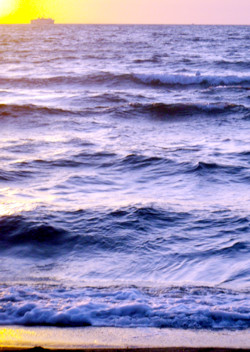La soluzione era stata indicata per far abbassare il livello di CO2 in atmosfera. Ma vale la pena correre rischi così seri e così elevati sia per l’ambiente marino, sia per la salute umana? Non sarebbe molto meglio evitare di inquinare l’atmosfera del pianeta?
È giunta notizia che un gruppo di ricercatori sull’ambiente marino dell’Università della California, in collaborazione con l’Università della Luisiana e l’Università della Carolina del Sud, ha effettuato una ricerca, finanziata dalla National Science Foundation, sullo sviluppo di alghe in ambiente marino a seguito di fertilizzazione dell’oceano mediante ferro. I risultati di questa ricerca saranno pubblicati questa settimana sui «Proceedings of the National Academy of Science».
Il metodo di fertilizzazione degli oceani mediante ferro è una delle soluzioni proposte e caldeggiate anche nell’ambito dei negoziati internazionali sul clima, come un efficace «sink» dell’anidride carbonica, cioè come strumento efficace, anzi addirittura molto più efficace della forestazione e riforestazione, per l’assorbimento dell’anidride carbonica atmosferica da parte dei processi di fotosintesi delle alghe marine.
Ebbene questa ricerca dimostra che questa soluzione è molto pericolosa, perché tra le varie alghe, si sviluppano alghe molto tossiche, a rapido accrescimento, produttrici di una neurotossina: l’acido domoico, solubile in acqua e capace di entrano nella catena alimentare di tutta la fauna marina.
L’acido domoico si accumula in particolare nei molluschi, nei crostacei e soprattutto nei pesci (come il pesce azzurro), ma anche degli uccelli marini. E le neurotossine, come l’acido domoico, sono veleni mortali per alcuni molluschi, e anche se non uccidono i pesci, sono fortemente tossici per gli altri animali marini superiori della catena alimentare che si nutrono di pesce come le foche ed i leoni marini. Alla fine della catena alimentare c’è l’uomo, che rischia di trovare le neurotossine nella sua alimentazione, qualora composta di pesce o di frutti di mare
A parte il fatto che la fertilizzazione degli oceani mediante ferro provoca anche una acidificazione delle acque marine con tutti i problemi che ciò comporta per le barriere coralline e sugli equilibri ecosistemici, la domanda da porsi è questa: Ma vale la pena correre rischi così seri e così elevati sia per l’ambiente marino, sia per la salute umana, per sottrarre anidride carbonica all’atmosfera e rallentare i cambiamenti climatici? Non sarebbe molto meglio evitare di inquinare l’atmosfera del pianeta? (V. F.)
Iron stimulates blooms of toxin-producing algae in open ocean, study finds
SANTA CRUZ, CA – 8-Nov-2010- -A team of marine scientists has found that toxin-producing algae once thought to be limited to coastal waters are also common in the open ocean, where the addition of iron from natural or artificial sources can stimulate rapid growth of the harmful algae. The new findings, reported this week in the Proceedings of the National Academy of Sciences, add to concerns about proposals to use iron fertilization of the oceans as a way to combat global warming.
Blooms of diatoms in the genus Pseudo-nitschia, which produce a neurotoxin called domoic acid, are a regular occurrence in coastal waters. During large blooms, the algal toxin enters the food chain, forcing the closure of some fisheries (such as shellfish and sardines) and poisoning marine mammals and birds that feed on contaminated fish. But until now, blooms of these algae in the open ocean have attracted little attention from researchers.
“Normally, Pseudo-nitschia cells are sparse in the open ocean, so they don’t have much effect. But these species are incredibly responsive to iron, often becoming dominant in algal blooms that result from iron fertilization. Any iron input might cause a bloom of the cells that make the toxin,” said Mary Silver, professor emerita of ocean sciences at the University of California, Santa Cruz, and lead author of the new study.
Because both natural and artificial additions of iron to ocean waters cause phytoplankton (single-celled algae) to grow vigorously, and because phytoplankton take up carbon dioxide as they grow, iron fertilization of the oceans has been suggested as way to reduce atmospheric concentrations of carbon dioxide and thereby combat global warming.
“This work definitely reveals a wrinkle in those plans,” said coauthor Kenneth Coale, director of Moss Landing Marine Laboratories. “It is much easier to break an ecosystem than it is to fix one. In light of these findings, we should redouble our efforts to reduce carbon emissions, the primary culprit for ocean ecosystem damage worldwide.”
In 2007, Silver accompanied Ken Bruland, professor of ocean sciences at UCSC, on a research cruise to study iron chemistry in the Gulf of Alaska. She saw Pseudo-nitschia cells often in samples collected at sea, and analysis of the samples back in the lab showed the presence of the domoic acid toxin. Those findings prompted her to team up with Coale to analyze old samples collected during iron-enrichment experiments conducted in 1995 and 2002. Coale was the principal investigator or chief scientist for these studies.
“We thought the toxin would have broken down, but it was still there,” Silver said.
In addition to samples from the two iron-enrichment experiments, the researchers analyzed samples from three natural populations in the North Pacific. The results showed that oceanic waters throughout the Pacific contain Pseudo-nitschia populations associated with the domoic acid neurotoxin.
Silver noted that blooms of Pseudo-nitschia must occur naturally in the open ocean as a result of iron deposited by dust storms, volcanic eruptions, and other airborne sources. “It is a natural phenomenon and likely has been for millions of years,” she said. “But those are sporadic occurrences. To do iron enrichment on a large scale could be dangerous because, if it causes blooms of Pseudo-nitschia, the toxin might get into the food chain, as it does in the coastal zone.”
















